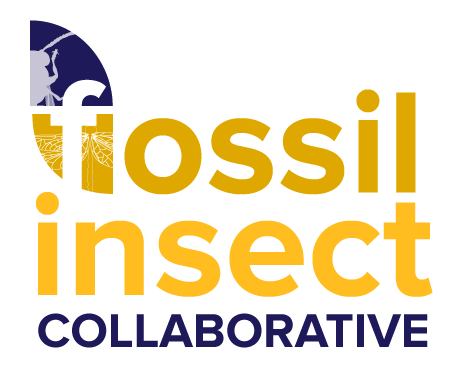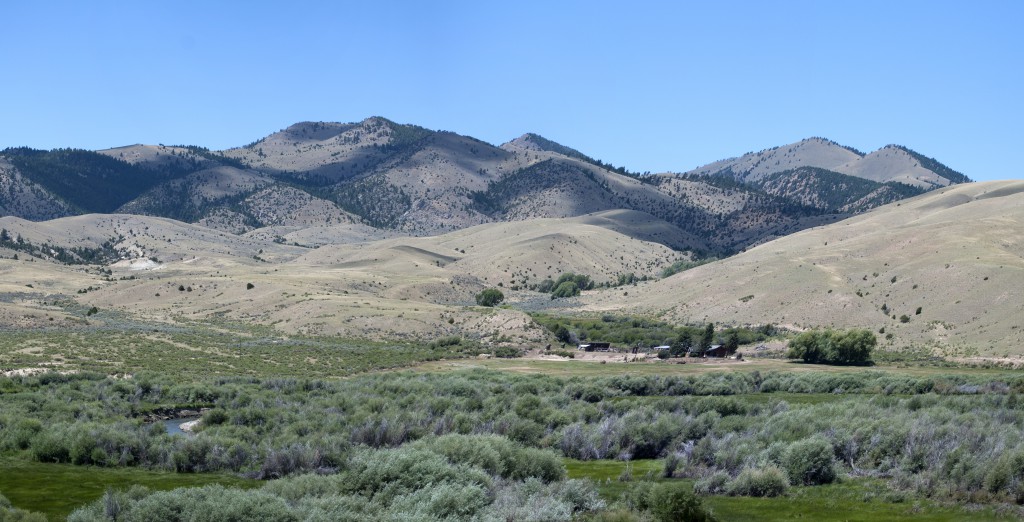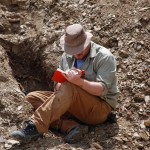In July and August of this year, Fossil Insect Collaborative scientists Sam Heads and Jared Thomas of the Illinois Natural History Survey led an expedition to the Ruby Valley in southwest Montana to collect fossil insects and plants from the paper shales of the Renova Formation. These highly siliceous lacustrine deposits yield a diverse and exceptionally preserved assemblage of fossil insects and plants dating to the Late Oligocene, approximately 25 million years ago. At that time the Ruby Valley was dominated by a series of lakes formed in post-Laramide extensional basins that were periodically blanketed with ash from volcanoes further west. One of these basins—appropriately named Fossil Basin—lies just west of the Ruby Reservoir near the small town of Alder in Madison County. It was this basin that was the focus of the expedition.
- Team members prospect for fossils at one of the sites. (Photo by M. Jared Thomas)
- Fossiliferous paper shales and intercalated tuffaceous siltstones in situ with pickaxe for scale. (Photo by Nate Stariha
- Varve-like lamination hints at cyclic sedimentation and offers important insight into the depositional environment of the ancient lake. (Photo by M. Jared Thomas)
The expedition comprised scientists from both the Illinois Natural History Survey and the Illinois State Geological Survey, and aimed to retrace the steps of the late paleobotanist Herman Becker, who first explored Fossil Basin in the 1950s and documented abundant well-preserved fossil plants. Becker also collected a number of fossil insects, providing a tantalizing glimpse of the ancient insect fauna. Heads and Thomas aim to further document the diversity of fossil insects from these deposits and reconstruct the environment and climate of the ancient Fossil Basin lake. To do this, the team mapped the geology of the valley in detail, relocating some of Becker’s original localities and opening new excavations, collecting several hundred new insect and plant specimens. This expedition was the first of many planned visits to the area and the team will return in summer 2016 for further fieldwork.
- Dr. Heads recording field notes at one of the excavations. (Photo by M. Jared Thomas)
- Dr. Heads and Jared Thomas searching for fossil insects. (Photo by Nate Stariha)
- Dr. Heads takes detailed notes about each specimen obtained in the field each day. (Photo by Nate Stariha)
Fossil insects found during the 2015 trip include numerous groups mostly representing aquatic forms, such as mayfly and dragonfly larvae, crane flies, and caddisflies. Other taxa collected include ants, spittlebugs, grasshoppers and abundant weevils. In addition to insects, the team also collected a wide variety of plants, mostly represented by leaves, many with obvious insect feeding damage. Other plant fossils found include abundant pine needles and numerous winged seeds. With future, more targeted excavations planned, the team hopes to develop a more complete picture of this important ancient biome.
- 7. A crane fly (Diptera: Tipulidae). Many fossils from the paper shales comprise a part and counterpart, as the shale often splits through the middle of the specimen. (Photo by M. Jared Thomas)
- 9. Aquatic larva of a squaregill mayfly (Ephemeroptera: Caenidae). (Photo by M. Jared Thomas)
- A samara, or winged seed, perhaps from a maple or ash tree. (Photo by M. Jared Thomas)
- Fossilized leaf showing insect feeding damage. (Photo by M. Jared Thomas)
- Unidentified fly (Diptera). (Photo by M. Jared Thomas)













